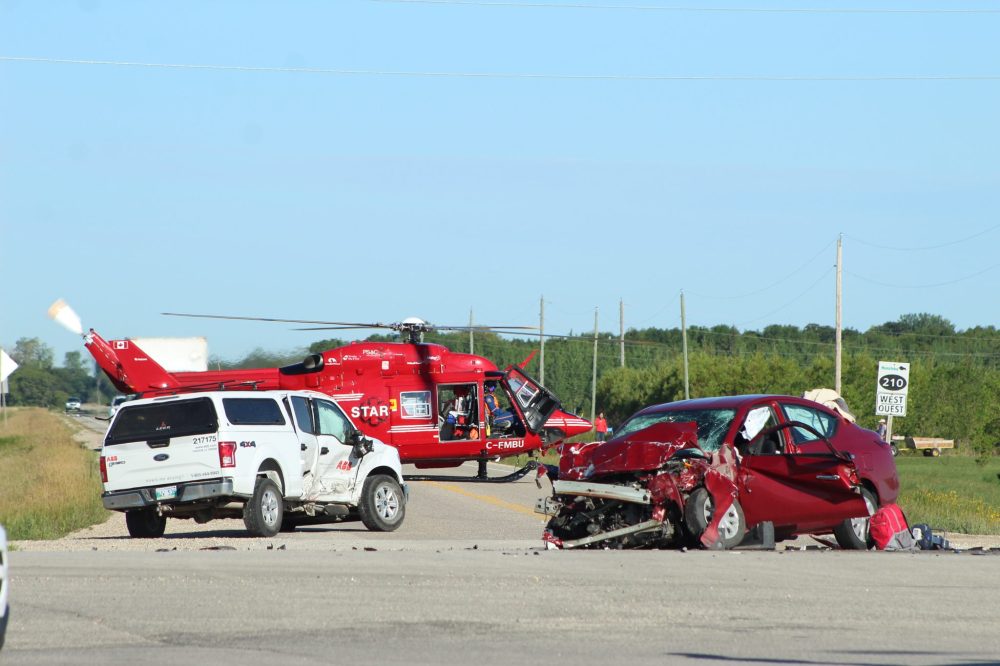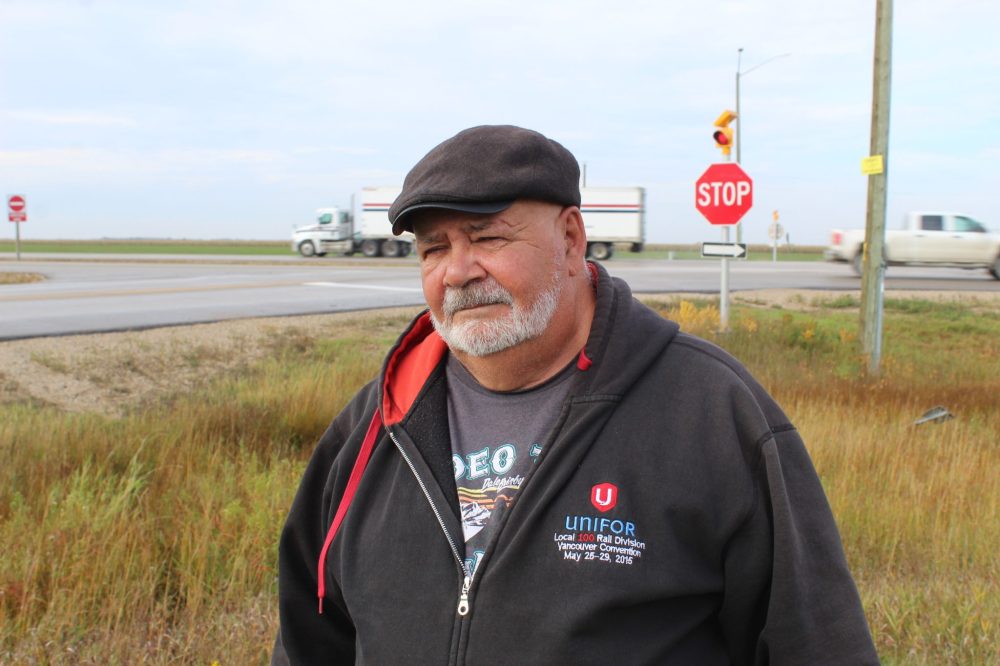Traffic lights urged for problem intersection
Advertisement
Hey there, time traveller!
This article was published 14/10/2022 (988 days ago), so information in it may no longer be current.
A growing number of voices are calling on the province to install a set of traffic lights at a busy highway intersection prone to serious collisions.
Ste Anne resident Roger Lilley says the province shouldn’t wait for another crash to occur before installing traffic lights at the intersection of Highway 12 and Provincial Road 210 near Ste Anne.
Lilley, whose friend was involved in an accident at the intersection four years ago, is going public with his long-simmering safety concerns in the hopes of spurring the province to act.

Statistics from the province and Steinbach RCMP show the intersection has averaged one collision every seven and a half weeks for seven years.
From 2016 to 2020, a total of 35 collisions were reported at or within 500 metres of the intersection, causing a total of 39 injuries and one fatality, a provincial spokesperson said.
That timeframe excludes a September 2015 collision between a car and a semi-trailer that killed two elderly women from the RM of Ste Anne.
Others have suffered life-altering injuries in crashes at the intersection. In August 2020, a sedan driven by 27-year-old Brianna Seewald of Mitchell was struck by a pickup truck crossing Highway 12.
Seewald was airlifted from the scene with broken ribs, a fractured neck and back, and a torn artery. She spent five weeks in hospital then returned home in a wheelchair to begin a long recovery. Two years ago, she told this newspaper she’d like to see lights installed at the intersection.
A month after Seewald’s collision, Dawson Trail MLA Bob Lagasse and then-Infrastructure Minister Ron Schuler announced five “interim safety enhancements” for the intersection, including rumble strips, flashing red lights for stop signs, and reduced speed limits for eastbound vehicles approaching the intersection.
Those steps haven’t reduced the average frequency of collisions, according to statistics from Steinbach RCMP Staff Sgt. Harold Laninga, who said his detachment responded to seven collisions at the intersection last year, and seven more this year—an average of one crash every seven and a half weeks.
Lilley said he now avoids the intersection and uses the overpass located a mile north. He said the added safety is worth the slightly longer drive.
Population growth and rising traffic counts have convinced the province to add lights elsewhere in the region. Lilley said he can’t figure out why Ste Anne is an outlier.
“Blumenort and Mitchell both have lights.”
A set of temporary traffic lights was erected at the intersection of Highway 12 and Provincial Road 210 during roadwork in 2014.
“Why did they take them down?” Lilley said. “It doesn’t make any sense.”
Manitoba Infrastructure began a safety review of the intersection two years ago. A report was due last fall, but RM of Ste Anne council has yet to see any recommendations from it, Reeve Paul Saindon said last week.
A provincial spokesperson said the safety review suggested “a number of alternate solutions” for the department to consider.
The department is now beginning a functional design study to “develop options for consideration including the potential for major changes which may include re-routing of traffic in this area.”
The design study will include public consultations and take 10 to 12 months to complete, the spokesperson said.
Lilley said he can’t understand why the province isn’t moving more quickly.
“I don’t know how many studies and models you need,” he said. “It always boils down to the same thing: people need to die before they’ll do something.”
Lagasse and Infrastructure Minister Doyle Piwniuk were asked about the intersection during an Oct. 3 press conference near Ste Anne.
“We’re actually having it designed right now to make sure that traffic will be redirected to an interchange, and so that will be safer for Manitoba drivers in that intersection,” Piwniuk said. “We know it’s a problem, but we’re working on a long-term solution.”
Piwniuk clarified he was referring to the existing overpass.
“That’s what we’re trying to do because that’s kind of a solution that makes more sense, because the fact is, that’s what interchanges are for.”
Piwniuk’s response didn’t sit well with Lilley, who believes motorists will continue to take the shortest route to and from Ste Anne, even if it’s more dangerous.
“The simplest solution is just to put up lights,” Lilley said.
Saindon, too, found the minister’s response lacking.
“Good luck with that encouragement,” he said. “Habits are hard to break.”
Lagasse said the intersection’s proximity to an existing overpass is a factor to consider, but cautioned the department needs time to formulate several options and present them to the public. In the meantime, Lagasse encouraged drivers to use the overpass.
“And if you don’t want to wait for the train, guess what, the overpass bypasses that as well.”
Lilley said he has talked to school bus drivers who use the intersection daily.
“They say it’s like rolling dice when they cross that highway.”
Cliff Fuhr, transportation supervisor for Seine River School Division, said division school buses pass through the intersection 120 times per day.
“It’s not just the Ste Anne buses,” Fuhr said. “It’s our buses that go out to St Norbert, the ones that go out to Ile des Chenes, the ones that go out to La Salle and Lorette. We use that road [Provincial Road 210] a lot.”
Fuhr said division bus drivers prefer Provincial Road 210 to the Trans-Canada Highway because it has less congestion and heavy truck traffic.
Fuhr said the division hasn’t had an accident at the corner of Highway 12 and Provincial Road 210 in more than 27 years.
“Our drivers, they know that intersection,” he said. “A lot of the drivers that are on it are veteran drivers, so they know how to proceed at that intersection.”

Still, Fuhr said the intersection concerns him. Drivers often speed up to get ahead of a school bus, creating even more danger.
“It’s an intersection that can cause a problem. It’s very dangerous because people don’t wait, people are in a rush.”
A few weeks ago, Fuhr waited on Highway 12 for 45 minutes while emergency crews cleared away another crash. Last week, while on his way to Steinbach, he briefly followed a southbound driver travelling 118 km/h.
“Signs are not going to do anything,” Fuhr said. “People are still going to give-er, they’re still going to floor it. The best way, in my opinion, is putting up a set of lights there. That’ll eliminate this problem.”
DSFM also operates a school in Ste Anne. An interview request was not fulfilled by press time.
Lilley said motorists attempting to turn left onto Highway 12 sometimes misjudge how fast oncoming traffic is approaching.
“They see the traffic, they say, ‘Oh, I’ve got lots of time.’”
The RM of Ste Anne has written the province about the intersection. Two years ago, Saindon preferred a reduced speed limit zone on Highway 12. He now prefers a roundabout.
“You’d have no sitting and idling, no sudden stops,” he said.
Richard Pelletier, the outgoing mayor of the Town of Ste Anne who is campaigning to become reeve of the RM of Ste Anne, did not return interview requests by press time. Two years ago, Pelletier said it was unlikely the province would install lights so close to an overpass.
Lilley said Ste Anne Police support his call for traffic lights.
“They’re a thousand percent behind this.”
Police Chief Marc Robichaud said that’s not his department’s official stance, as the intersection lies outside its policing area. But he conceded emergency personnel frequently attend the intersection.
“If we see the fire truck leaving town going towards the Number 12, we automatically assume that it’s an accident there,” Robichaud said.
He encouraged motorists to “pay extra special attention” when approaching the intersection.
“Sometimes maybe taking extra time at an intersection like that would be prudent.”
Saindon said inattentive drivers, not design flaws, are to blame for collisions at the intersection.
“If you follow the proper driving rules, there is no problem with the intersection,” he said. “It’s all human error all the time.”
While sightlines at the intersection aren’t impeded by trees or development, Lilley said eastbound and westbound motorists must contend with the sun in their eyes.
The intersection has become a political topic in Dawson Trail ahead of next year’s provincial election.
NDP candidate Chris Wiebe, who has already started campaigning to unseat Lagasse, supports Lilley’s quest for safety improvements.
“It’s a huge public safety issue,” Wiebe said.
He believes the Progressive Conservative government’s “musical chairs of ministers” is a factor delaying safety upgrades.
Wiebe said Lagasse hasn’t been advocating enough for safety improvements at the intersection, and hasn’t been responsive to constituents concerned about it.
Lilley said he has called and visited Lagasse’s Ste Anne constituency office to no avail. Last week, Lagasse said the intersection is a topic constituents don’t often bring up.
“We haven’t had anything come into the office since we’ve announced the [2020] safety upgrades. It’s been pretty quiet,” he said.
“Well, he’s lying,” Lilley said. “That or he’s living under a rock.”
In a follow-up written statement, Lagasse said the NDP had 17 years to do something about the intersection.
“Our PC Team knows this is a priority and we’re working to get it done right—unlike the NDP did.”
Lilley said it seems like Dawson Trail isn’t getting its fair share of infrastructure dollars, despite significant growth in Ste Anne.
“If they can find money for Steinbach, Mitchell and Blumenort, why can’t they find it here?”
